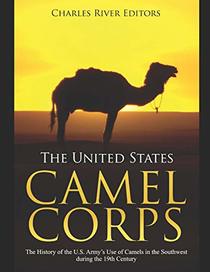Every once-in-a-while Charles Rivers chooses an unusual topic and this is one of those times. This is a great story about a little-known part of our American history. It is well worth the reader's time to learn a great deal about a brief interlude.
Several things surprised me. Camels can work in the desert without food or water for 17 days. They can transport 660 lbs. over long distances or 1000 lbs. over short distances. Certainly, they can out-work mules or horses. Camels actually evolved in North America eons ago before becoming extinct about 13,000 years ago.
There's an interesting story just in the transporting of camels by Lt. David Porter. The author pulls in names of some folks we would know (Jefferson Davis) and others who were important (Gwynn Harris Heap, brother-in-law to Porter, who knew Arabic and was familiar with Muslim culture). Porter and Davis emerge again in the Civil War, and the author explains their importance later.
There are lots of photos of important people in the story. One unique facet was the importation of 89 camels (having no connection with the Army) to Galveston, TX. The port officials were suspicious and refused entry of the camels, so they were dumped in Galveston. They were troublesome in the city but eventually died of neglect.
The Civil War ended the camel experiment. Although the camels performed well, they were not accepted by the local population or the mule and horse sellers across America. Essentially, animals were no longer needed when the transcontinental railroad was completed. So then the author turns our eyes to camels imported to Australia for the same uses (at about the same time). Unlike the US, Australia still has a herd of feral camels that do considerable damage.
This is one of those fun books Charles Rivers sometimes produces that offer a wealth of information about obscure bits of our past. Enjoy.
Several things surprised me. Camels can work in the desert without food or water for 17 days. They can transport 660 lbs. over long distances or 1000 lbs. over short distances. Certainly, they can out-work mules or horses. Camels actually evolved in North America eons ago before becoming extinct about 13,000 years ago.
There's an interesting story just in the transporting of camels by Lt. David Porter. The author pulls in names of some folks we would know (Jefferson Davis) and others who were important (Gwynn Harris Heap, brother-in-law to Porter, who knew Arabic and was familiar with Muslim culture). Porter and Davis emerge again in the Civil War, and the author explains their importance later.
There are lots of photos of important people in the story. One unique facet was the importation of 89 camels (having no connection with the Army) to Galveston, TX. The port officials were suspicious and refused entry of the camels, so they were dumped in Galveston. They were troublesome in the city but eventually died of neglect.
The Civil War ended the camel experiment. Although the camels performed well, they were not accepted by the local population or the mule and horse sellers across America. Essentially, animals were no longer needed when the transcontinental railroad was completed. So then the author turns our eyes to camels imported to Australia for the same uses (at about the same time). Unlike the US, Australia still has a herd of feral camels that do considerable damage.
This is one of those fun books Charles Rivers sometimes produces that offer a wealth of information about obscure bits of our past. Enjoy.




